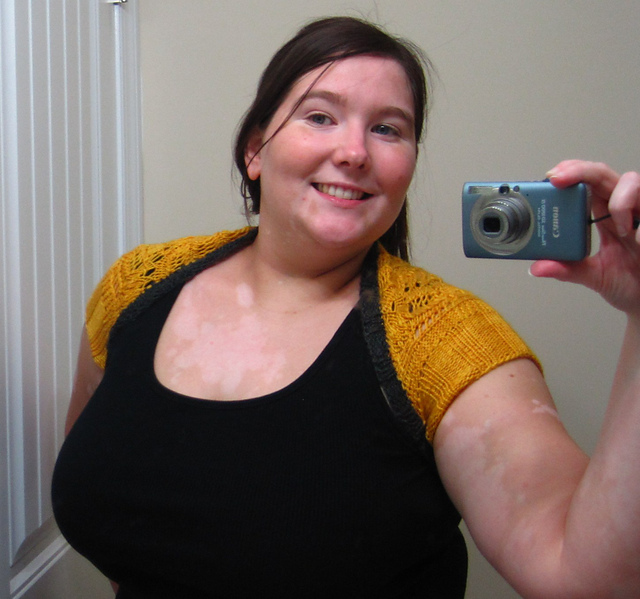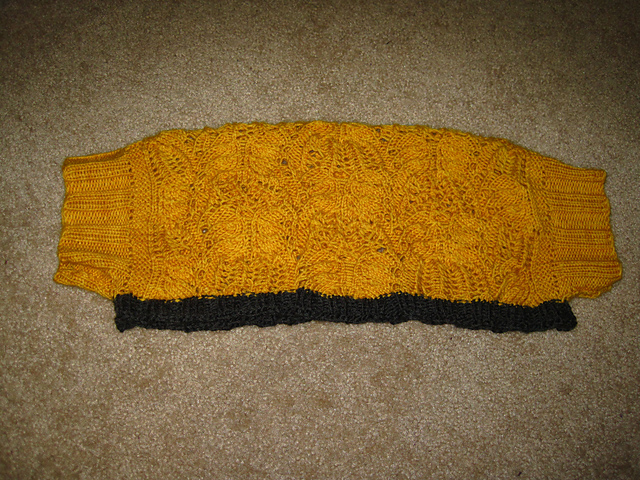So, it's spring, and I got some yarn in a beautiful, springtimey color but ... I only got about 235 yards. (You're thinking,
What?! I know. But it was available.)
So, The Unique Sheep, superwool DK in Gold Ochre is what I used for the body and I accented it with a charcoal grey yarn that I had left over from making my brother's Christmas present: Caron Country, which is listed as a worsted weight yarn but actually works more like a DK. I love yellow and grey together and I thought that they were both in the same tone/feel to the color, and it worked for me.
I knitted the whole thing on size 5 (US) needles. I didn't swatch, per se, but measuring the final piece I've got 3 inches for 12 stitches and 2.5 inches for 8 rows(bound off) of k3/p3 ribbing, blocked.
I wanted to do something with it that was not a scarf, I wanted something spring but also wearable. And for me, springtime is all about flowers. I thought about it and decided there was no better pattern (for me) than the frost flowers pattern.
Approximately 33 inches
around armpit-to-armpit (unstretched), although it stretches a great deal.
About 21 inches from sleeve to sleeve (the whole width of the garment). But again, it stretches a great deal.
Stretched the numbers are closer to 48 inches and 29 inches, respectively.
Armholes are about 12 inches around, unstretched, but stretch to about 16 around.
Stretch is important here because I'm stretching the garment about to its limit when I wear it, but if I'd had more yarn I'd have made it slightly larger!
Pictures:
I call it
Flowers after the Frost. And my pattern is more a recipe of how to make it than anything else. I don't think there's going to be a ton of variability possible in the size because the pattern itself is only two repeats wide (you'd have to be VERY skinny to rid yourself of the second repeat!) though the fit can certainly be adjusted for those who might, say, have a bit more yarn. :)
The overall design went like this:
Main portion (lace) followed by arm-ribbing. Block, then sew armholes, then pick up stitches around for grey section.
Lace portion:
The lace is in two 4-row sections, each of which is repeated three times before switching to the next section. This means that you do
Row 1, Row 2, Row 3, Row 4, Row 1, 2, 3, 4, 1, 2, 3, 4,
then
Row 5, Row 6, Row 7, Row 8, Row 5, 6, 7, 8, 5, 6, 7, 8
until completion.
Cast on 78 stitches in your preferred method (I used long-tail).
Setup row: K4, pm, K70, pm, K4. There will be four stitches of garter edging on either side. (I liked to have a base row on either side that wasn't immediately lace, so there is a matching all-knit row at the end.)
Updated: I missed a very important K2 in row 7.
Rows are:
- K4, sl m, K4, *K2tog, K4, yo, P2, [K2, yo, sl1, K1, psso] 3x, P2, yo, K4, sl1, K1, psso**, K6, repeat from * to **, K4, sl m, K4
- K4, sl m, P3, *P2tog tbl, P4, yo, P1, K2, [P2, yo, P2tog] 3x, K2, P1, yo, P4, P2tog**, P4, repeat from * to **, P3, sl m, K4
- K4, sl m, K2, *K2tog, K4, yo, K2, P2, [K2, yo, sl1, K1, psso] 3x, P2, K2, yo, K4, sl1, K1, psso, K2**, repeat from * to **, sl m, K4
- K4, sl m, P1, *P2tog tbl, P4, yo, P3, K2, [P2, yo, P2tog] 3x, K2, P3, yo, P4, P2tog**, repeat from * to **, P1, sl m, K 4
Remember that these four rows are repeated in sequence three times before moving on to the next row.
- K4, sl m, K 1, *yo, sl1, K1, psso, K2, yo, sl1, K1, psso, P2, yo, K4, sl1, K1, psso, K6, K2tog, K4, yo, P2, K2, yo, sl1, K1, psso**, K2, repeat from * to **, K3, sl m, K4
- K4, sl m, P1, *yo, P2tog, P2, yo, P2tog, K2, P1, yo, P4, P2tog, P4, P2tog tbl, P4, yo, P1, K2, P2, yo, P2tog**, P2, repeat * to **, P3, sl m, K4
- K4, sl m, K1, *yo, sl1, K1, psso, K2, yo, sl 1, K1, psso, P2, K2, yo, K4, sl1, K1, psso, K2, K2tog, K4, yo, K2, P2, K2, yo, sl1, K1, psso**, K2, repeat from * to **, K3, sl m, K4
- K4, sl m, P1, *yo, P2tog, P2, yo, P2tog, K2, P3, yo, P4, P2tog, P2tog tbl, P4, yo, P3, K2, P2, yo, P2tog**, P2, repeat from * to **, P3, sl m, K4
Remember that these four rows are repeated in sequence three times before moving back to the first row.
Repeat these rows in sets of 12-rows-at-a-time until your piece is long enough to wrap around your arm.
I did 108 rows total; that is, the first 12-row section was done 5 times and the second 12-row section was done 4 times.
Knit across 1 row (as described above).
I left my stitches live and
did not bind off, just moved my live stitches onto spare wires!
Sleeves:
[
Nota Bene: I worked these flat and then seamed them because I wasn't certain if this would be slightly-too-tight on my arms, again, I was making it as small as would possibly fit. Feel free to knit this in the round if you prefer, though then you'll want an exact multiple of 3 stitches picked up. You'll also want to block the lace portion first.]
Along both the left and right garter edges I picked up 56 stitches (half of the number of rows knit in pattern, for those making a different number of rows).
On the right side and left side I did reversed patterns so that they would match when facing. That is:
Side 1: P4, [K3, P3] to 4 stitches from end, K4
Side 2: K4, [P3, K3] to 4 stitches from end, P4
Your numbers will vary if you pick up a different number of stitches.
I repeated each side for 21 rows, then bound off.
 Construction:
Construction:
At this point, I blocked what I had.
Once it was dried, I sewed up the ribbed portion of the sleeves. This is where the customization comes in:
In my case, I was able to sew it up right up to the end of the ribbing, though for skinnier folks, you may want to sew in further and for those who are wider, you'll want to sew less.
Collar:
Because I had 78 stitches across the bottom (still live) I picked up 3 stitches at each armpit (where the sleeves are) and then the other 78 cast on stitches across the top. This makes a perfect multiple of 3 for K3/P3 ribbing.
I repeated this for 7 rows and then bound off with
Jeny's surprisingly stretchy bind off. (I highly recommend Cat Bordhi's
video for those who learn like me, since she demonstrates binding off in ribbing!)
In the end, it looks like this when flat:
I'm now working on a version of this in a cotton yarn, so any thoughts/comments I have on that are going in my blog's
next post.











